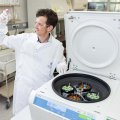More efficient use of agricultural sprays with less chemical drift are expected to result from a world class research facility at The University of Queensland'sGatton Campus.
The sophisticated wind tunnel which is the only one of its type in Australia drew praise from peak industry regulators during a field visit this week.
Leaders of the National Registration Authority for Agricultural and Veterinary Chemicals inspected the facility before holding a full board meeting in Brisbane.
NRA chairman John Keniry said the wind tunnel, jointly funded by the University of Queensland and the Cotton Research and Development Corporation, would be an asset to rural industry.
"It's certainly impressive. The more we can understand about chemical droplet size and spray drift, the better the outcomes that can be achieved," Dr Keniry said.
Scientific outcomes achieved at UQ Gatton would make an important contribution to precision agriculture.
The wind tunnel, which began operating earlier this year, has already been used for chemical research by companies and groups from the United States, the United Kingdom and New Zealand. The US Spray Drift Task Force consortium project manager Dr. Andrew Hewitt said he considered the UQ Gatton facility "THE" facility for wind tunnel testing (in the world).
The director of the UQ Gatton-based Centre for Pesticide Application and Safety, Nicholas Woods, said extensive use would be made of the sophisticated wind tunnel by scientists and students as well as multi-national corporations developing new chemical products and companies proving new spray nozzle technology.
The technology is expected to be used for the analysis of a comprehensive range of ground and aerial spray application systems.
"The cotton industry had the foresight to make a major capital contribution to develop the facility at our national research centre," Mr. Woods said.
"It complements the application technology work that has been carried out by scientists at UQ Gatton over many years."
The wind tunnel, housed in its own secure building, had an electric turbine capable of generating wind speeds up to 150 knots to simulate aerial spray application. It was built to an aerodynamic design developed by CSIRO engineering experts.
The most minute spray droplets and their scatter pattern are measured by a laser beam and captured for computer analysis and simulation. Spray drift models developed are used in the chemical registration process.
"The beauty of this facility is that we can exercise absolute control for precision measurement. Results can then be verified under field conditions if required," Mr. Woods said.
For further information, contact Nicholas Woods on (07) 5460 1293.



